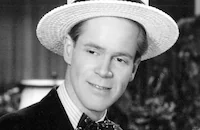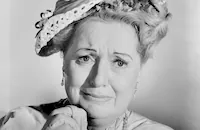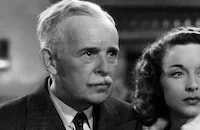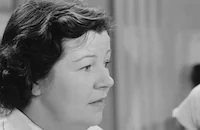Mrs. Parkington

Brief Synopsis
Cast & Crew
Tay Garnett
Greer Garson
Walter Pidgeon
Edward Arnold
Agnes Moorehead
Cecil Kellaway
Film Details
Technical Specs

Synopsis
On Christmas Eve, 1938, Susie Parkington, the eighty- four-year-old matriarch of a wealthy New York family, learns that her great-granddaughter, Jane Stilham, is about to elope with Ned Talbot, a former employee at her father Amory Stilham's investment firm. Susie presses Jane to introduce her to Ned before they depart and, while she is waiting for them, remembers the first time she met her now-deceased husband, Major Augustus "Gus" Parkington: In 1872, Gus, an infamous playboy tycoon, arrives in Leaping Rock, Nevada, to inspect his silver mine and spies eighteen-year-old Susie Graham in her mother's boardinghouse. Gus insists on staying at the full boardinghouse, and Susie eagerly gives up her room to him. Susie impresses Gus with her resourcefulness and beauty, and she is equally entranced by his wealth and power. When her mother is killed in an explosion at Gus's unsafe mine, however, Susie is overcome with grief.
Feeling responsible for Susie, Gus convinces her to marry him and takes her back to New York City. As soon as they arrive there, Gus breaks the news of his marriage to his former lover, Baroness Aspasia Conti. Although hurt, the sophisticated French woman befriends Susie and teaches her how to act like a rich man's wife. Back in the present, Ned arrives at Susie's mansion, and Susie, sensing trouble, coaxes him into confessing that he quit his job because he knew that government agents were investigating Amory and were about to arrest him for theft and fraud. When Amory shows up, Ned confronts him with his crime, then prevents him from shooting himself. Feeling protective of her father, Jane denounces Ned, who storms off in anger. Amory admits that he embezzled his investors' money in a desperate attempt to recoup Wall Street losses and asks Susie for a thirty-one million dollar loan to prevent his arrest. Noting that the money constitutes her grandchildren's inheritance, Susie orders all of her relatives to come to her home to discuss the situation.
Before their arrival, Susie recalls more about her life with Gus: On their third wedding anniversary, Gus surprises Susie with a palatial house decorated by Aspasia, and Susie surprises him by announcing she is pregnant. Thrilled by the news, Gus decides to host an elaborate ball in Susie's honor. Only a few guests show up, however, and Susie learns from lawyer John Marbey that earlier in the day, Gus inadvertently insulted one of their invited guests, the influential George Beaumont, who then demanded that Gus be blackballed. Furious, Gus orders the hired musicians and servants to eat the prepared feast and drives the guests away. The upset Susie suffers a miscarriage, and Gus blames Beaumont and his friends for the loss and vows revenge. Four years later, Susie finally learns about Gus's plot to ruin everyone who stayed away from the ball and denounces him for it. Defying his orders, she then moves out and, with Marbey's and Aspasia's help, uses Gus's money to restore the fortunes of some of his victims. When Gus hears what she has done, he is at first enraged, but then admits he is impressed with her cleverness. The two reconcile and Gus pledges to make Susie his partner both in business and love.
Back in the present, Susie's extended family meets to decide Amory's future, and all vote to deny him their inheritance. When Amory announces he is giving himself up, Jane, his only ally, embraces him. After Amory leaves, Susie comforts Jane and remembers a dark time in her own life: Overwhelmed with grief over the accidental death of her only son, Susie has become a recluse. Having just returned from Europe, a concerned Aspasia visits her one day and reports that Gus, from whom Susie has been separated for a year, is thriving in his English home and has become involved with Lady Norah Ebbsworth. Revived by jealousy, Susie sails immediately with Aspasia, first to France, where her daughter Alice lives, and then to England. Susie arrives at Gus's place unannounced, and while Gus engages in a fox hunt with the much-younger Lady Norah, Susie meets Edward, Prince of Wales.
Taken with Susie, Edward helps her to win back Gus by asking Lady Norah to become his mother Victoria's new lady-in-waiting, an offer he knows she is socially obligated to accept. After Lady Norah makes a hasty departure, Aspasia tells Susie that she is returning permanently to France and confesses what Susie has long known--that she has always loved Gus. Gus and Susie then reunite and contemplate the future of their grandchildren. Inspired by her memories, Susie advises a weeping Jane to go after Ned and, after accusing her grandchildren of being weak and selfish, announces that she is going to repay Amory's debt with their inheritance and is moving back to Leaping Rock.

Director

Tay Garnett
Cast

Greer Garson

Walter Pidgeon

Edward Arnold

Agnes Moorehead

Cecil Kellaway

Gladys Cooper

Frances Rafferty

Tom Drake

Peter Lawford

Dan Duryea

Hugh Marlowe

Selena Royle

Fortunio Bonanova

Lee Patrick

Harry Cording
Celia Travers
Mary Servoss
Rod Cameron
Helen Freeman
Tala Birell

Hans Conreid
Gerald Oliver Smith
The St. Luke's Choristers
Ruthe Brady

Byron Foulger
Wallis Clark

Kay Medford
Edward Fielding
Alma Kruger
Rhea Mitchell
Ivo Henderson

Mary Zavian
Erin O'kelly
Myron Tobias
Eugene Borden
Charles Cane
Al Hill
Chuck Hamilton
Bert Lebaron
Al Ferguson
Richard Thorne
Lee Tung-foo
Marek Windheim
Johnny Berkes
Franco Corsaro
Anna Marie Stewart
Marcelle Corday
Bertha Feducha
Symona Boniface
Olga Borget
Robert Greig
Maurice Cass
Gordon Richards
Guy Bellis

Brandon Hurst
Rex Evans
Doodles Weaver
Bobby Barber
Chef Milani
Grace Hayle
George Carleton
Matt Moore
Noreen Roth
Charles Coleman
Billy Bletcher
Harry Tyler
Vernon Dent
Bud Jamison

Howard Hickman
Warren Farlow

Margaret Bert

Naomi Childers
Betty Bricker
Dorothy Phillips
Jessie Arnold
Natalie Draper
Joan Lawrence
Florence Howard
Harry Adams
Nolan Leary
John Bohn
Leonard Mellin
John Phipps
Billy Engle
Fred Rapport
Maurice Brierre
Charles Pecora
Walter Rode
William O'brien
Wilson Benge
Tom Tamerez
Gino Corrado
George Paris
George Calliga
Joseph North
Art Berry Sr.
Ed Kilroy
Carli Elinor
Myron Geiger
John Merkyl
Leonard Walker
Ray Flynn
Ben Gerien
Fred Fox
Robert Cory
Henry Sylvester

Howard Mitchell
Cosmo Sardo
George Mendoza
Allen Fox
William Norton Bailey
Mahlon Hamilton
Wyndham Standing
Major Douglas Francis
Harvey Shepard
Tiff Payne
Marjorie Wood
Crew
Edward Baravalle
George Boemler
Earl Cates
Mark Davis
Jack Dawn
Randall Duell
Herbert Fischer
Cedric Gibbons
A. Arnold Gillespie
Leon Gordon
Sydney Guilaroff
Danny Hall
Marion Herwood
Irene
Polly James
Bronislau Kaper
Standish J. Lambert
Frank B. Mackenzie
Major George C. Mcbride
M. J. Mclaughlin
Warren Newcombe
Mclean Nisbet
Joseph Ruttenberg
Douglas Shearer
Robert W. Shirley
Newell Sparks
William Steinkamp
Michael Steinore
Marvin Stuart
Robert Thoeren
Valles
John A. Williams
Edwin B. Willis

Photo Collections
Videos
Movie Clip



Trailer
Hosted Intro
Film Details
Technical Specs

Award Nominations
Best Actress
Best Supporting Actress
Articles
Mrs. Parkington
Garson was the reigning queen of the MGM lot when the studio bought the rights to Louis Bromfield's best seller for her. She had scored a hit in 1941 aging several years as a real-life social crusader in Blossoms in the Dust. This time, she would stretch to fill a role spanning seven decades and spend a considerable amount of her screen time as a grand dame in her 80s. Just to make the challenge more comfortable -- and add some more box office insurance -- they re-teamed her with Walter Pidgeon, her co-star not just in Blossoms but also in the Oscar®-winning Mrs. Miniver (1942) and the previous year's Madame Curie. They would ultimately team for eight films.
Also reunited with Garson on Mrs. Parkington was director Tay Garnett, although he had never worked on an actual film with her. Rather, he had discovered her for American pictures back in the mid-'30s when he was in England scouting locations for an independent film to star Douglas Fairbanks, Jr. He was also scouting talent there and tested Garson for a leading role after being impressed with her stage work. He wanted to sign her for the role, but production delays led to the film's cancellation. The test wound up in MGM studio head Louis B. Mayer's hands a few years later, and he signed Garson to a long-term contract, making her a star with her first U.S. film, Goodbye, Mr. Chips (1939). When Garnett came to MGM in the early '40s and scored hits with two wartime dramas, Bataan (1943) and The Cross of Lorraine (1943), assigning him to a Garson film seemed a natural choice.
Garnett's training as a gag writer for Mack Sennett and Hal Roach stood him in good stead working with Garson on Mrs. Parkington. In the film's early scenes, the 35-year-old actress had to overcome her typecasting as the great lady of the MGM lot to play a teenaged girl raised in a western mining town. Garnett got some help early on when Pidgeon agreed with him that Garson was playing her scenes with too much dignity. He slapped her on the rear end and advised her, "Relax, Honey. It was LAST year that you won the Oscar®." Garnett also came up with a piece of business Garson could use throughout the film to bring back her roots as a boarding-house maid: Whenever she became exasperated she would stick out her chin and blow a stray curl off her forehead. The first few times Garson did it, however, it didn't work. Finally, he told her she was trying too hard to be funny. "You mean I'm wearing a spangle on my nose?" she asked him. "Neon," he replied. From then on, whenever she overdid things, all Garnett had to do was put his finger on his nose, and she would pull back.
Also facing a challenge on Mrs. Parkington was character actress Agnes Moorehead. After years of playing spinsters and neurotics, she had to fight to convince studio executives that she could be elegant and witty enough for the role of Pidgeon's rejected mistress, who teaches Garson how to behave like a lady and ends up becoming her best friend. It helped greatly that she had just scored in a small role as Claudette Colbert's catty best friend in Since You Went Away (1944). Moorehead made the most of her few scenes in Mrs. Parkington, landing an Oscar® nomination and a Golden Globe. Her performance would anticipate her most famous role, as Elizabeth Montgomery's witty, glamorous mother on the hit TV series Bewitched.
Mrs. Parkington pleased Garson's growing legions of fans and even earned a few solid reviews, though most critics thought it a little too soapy for their tastes. It also brought Garnett and Garson another chance to work together the following year, in the upstairs-downstairs romance The Valley of Decision, which turned out to be an even bigger hit. With her popularity at MGM clearly growing, Garson won a new contract from the studio with very generous terms.
Producer: Leon Gordon
Director: Tay Garnett
Screenplay: Robert Thoeren, Polly James
Based on a novel by Louis Bromfield
Cinematography: Joseph Ruttenberg
Music: Bronislau Kaper
Art Direction: Cedric Gibbons, Randall Duell
Principal Cast: Greer Garson (Susie Parkington), Walter Pidgeon (Maj. Augustus Parkington), Edward Arnold (Amory Stilham), Frances Rafferty (Jane Stilham), Agnes Moorehead (Aspasia Conti), Selena Royle (Mattie Trounsen), Gladys Cooper (Alice, Duchess of Brancourt), Lee Patrick (Madeleine Parkington Stilham), Dan Duryea (Jack Stilham), Rod Cameron (Al Swann), Tom Drake (Ned Talbot), Cecil Kellaway (Edward, Prince of Wales), Hugh Marlowe (John Marbey), Tala Birell (Lady Nora Ebbsworth), Peter Lawford (Lord Thornley), Fortunio Bonanova (Signor Cellini), Kay Medford (Minnie), Hans Conried (Mr. Ernst), Alma Kruger (Mrs. Jacob Livingston), Doodles Weaver (Caterer), Chef Milani (Maitre d'Hotel), Donna Reed (Bit).
BW-124m. Closed captioning.
by Frank Miller

Mrs. Parkington
Quotes
Trivia
Notes
Louis Bromfield's novel was first published in Cosmopolitan. According to the CBCS, European release prints of the film included characters not in the domestic version. Hugo Haas, playing a Balkan king, replaced Cecil Kellaway as "Edward, Prince of Wales" in the American cast, and Tala Birell, who plays "Lady Norah Ebbsworth" in the U.S. version, appeared as a countess in the European version. In addition, the CBCS lists at least three actors-Ann Codee, Frank Reicher and George Davis-who were not in the final U.S. version but May have been in the European version. They are listed as playing French characters, and it is possible that scenes set in France were shot but were cut from the final U.S. version or were shot only for the European version.
Hollywood Reporter news items and production charts add the following information about the production: Donna Reed was cast in a part, but did not appear in the completed film. Madeleine LeBeau tested for the role of Lady Norah. Nana Bryant and Dewey Robinson were listed as cast members in Hollywood Reporter news items, but they were not in the released film. Another news item includes June Hillman in the cast, but her appearance in the final film has not been confirmed. Although Hollywood Reporter reported that Peter Lawford's character, "Lord Thornley," was to "make love" to Greer Garson's in the story, his part was reduced to one line in the U.S. version. The production, which required six weeks of tests and costume fittings, was shot chronologically, beginning with the 1872 sequence. The fox hunt sequence was filmed at Morrison Ranch, Agoura, CA. Locations were scouted in Nevada, but it is not known if any scenes were actually shot there. Although M-G-M publicity items state that Henrique Medina was to paint a portrait of Garson for the film, no such portrait was seen in the viewed print. It is possible that Medina painted a portrait of Walter Pidgeon for the picture, however. Garson and Pidgeon appeared together as husband and wife for the fourth time in this film. Garson was nominated for an Academy Award as Best Actress, but lost to Ingrid Bergman in M-G-M's Gaslight. On November 25, 1946, Lux Radio Theatre broadcast a radio adaptation of the film, starring Garson and Pidgeon, and on October 21, 1948, Hallmark Playhouse broadcast a version starring Rosalind Russell.

















